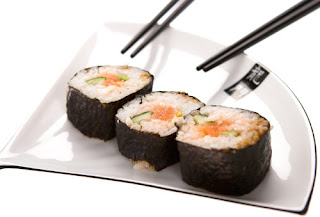Sushi is a Japanese food consisting of rice that formed along a side dish (neta) of seafood, meat, raw or cooked vegetables. Sushi rice has a soft taste sour because seasoned mixture of rice vinegar, salt, & sugar.
History of Sushi
It is said that the habit of preserving fish with rice and vinegar comes from mountainous regions in Southeast Asia.
The science behind the fermentation of fish packed in rice is that the vinegar produced from fermenting rice elaborate amino acids from fish meat. The result is one of the five basic tastes, called umami in Japanese.
In ancient times, Japanese people may be strong to eat because sushi is always served in large portions. Sushi as much as 1's (1 serving) equivalent to 9's (9 servings) sushi today, or roughly equal to 18 clod of sushi (360 grams). One serving sushi ancients called neta has ikkanzushi consisting of 9 or more types of seafood.
At that time, fish cooling techniques are still undeveloped. As a result, fish taken from the seas around Japan must be processed first in order not to damage when used as sushi.
Until the 1970's sushi is still a luxury food. Ordinary people in Japan just to eat sushi to celebrate special occasions, and limited to sushi home delivery.
Although the first restaurant opened kaitenzushi 1958 in Osaka, its spread to other areas in Japan takes a long time. Eating sushi as an event the whole family embodied in the 1980's in line with the increasingly widespread kaitenzushi.
The success kaitenzushi encourage food companies to introduce various kinds of sushi seasoning that allows instant housewives make sushi at home. chirashizushi or temakizushi can be made with herbs plus instant rice, seafood, tamagoyaki and nori.
Types of Sushi
:
1. Nigirizushi
Fresh seafood (usually raw) were placed on top of the rice which is formed by placing the rice in the palm of one hand and shape it with your fingers the other. Nori is often used to bind the neta that can not be separated from the rice. Side dish that is placed on top of sushi can also be cooked in a state like tamagoyaki or unagi eel and eel anago already baked.
2. Makizushi
Sushi rice rolls containing pieces of cucumber, another neta tamagoyaki and wrapped in nori sheets. Rice rolled with the help sudare (woven bamboo rectangular shape).
3. Chirashizushi
Rice is eaten with sushi neta of seafood and vegetables are cut into small pieces. Sushi rice was not formed but is loaded into the container of wood, a plate or bowl. Chirashizushi is one of the houses are popular dishes in Japan to commemorate special days like birthdays of children and Hina Matsuri celebration.
4. Oshizushi
Rice prepared with neta who pressed for a while with the intention of compressing the resulting sushi rice so that the rectangle-shaped and cut into pieces to be easily enjoyed. Oshizushi there is also wrapped in bamboo leaves and pressed for a while, between a few hours until one night.
5. Narezushi
Sushi antiquity is smeared salt fish and rice, then allowed to ferment. There is also a plus narezushi yeast to aid fermentation.
Special terms :
Sushi restaurant or sushi bar in Japan have specific terms that have other meanings in Japanese standard :
-Agari (green tea)
-Otesho (soy sauce)
-Kappa (cucumber)
-Gari (pickled ginger)
-Gyoku (tamagoyaki or dashimaki)
-Goad (nori)
-Gunkan (surrounded by sushi nori)
-Shari (rice for sushi)
-Tsume or nitsume
-Toro (tuna belly), subdivided according to fat content: ootoro and chutoro
-Namida or Sabi (wasabi)
-Haran or goods, (green leaf decoration sushi, now used plastic leaves)
-Murasaki (soy sauce)
Eating rules
- When taking sushi, use chopsticks or fingers.
- Dip the fish into shoyu (Japanese soy sauce), but do not let the rice. Do not get too much use of shoyu.
- Put all the sushi into his mouth with the tongue touching the fish.
- Use the tip of a blunt reply chopsticks when taking food from the plates together.
- After lunch, turn hashioki (a place to put chopsticks) with chopsticks
Don't Do It
- Rub chopsticks together to remove fragments. This could be considered rude.
- Biting sushi is half-half and put the rest on a plate.
- Eat the pickled ginger (gari) prior to devour sushinya.
- Enjoy the same piece of pickled ginger susi as a palate cleanser.
- Dipping all the parts of sushi rice on the damal shoyu because aka make sushi rice fell out.
- Entering into shoyu wasabi. Wasabi should be enjoyed together and put in sushi.
- Submit the money to the sushi chef. Sushi chef never touch the money while at work.







{ 0 comments... read them below or add one }
Post a Comment